Book contents
- Frontmatter
- PREFACE
- Contents
- ILLUSTRATIONS
- CHAPTER I THE TELESCOPE, ITS INVENTION AND THE DEVELOPMENT OF ITS POWERS
- CHAPTER II RELATIVE MERITS OF LARGE AND SMALL TELESCOPES
- CHAPTER III NOTES ON TELESCOPES AND THEIR ACCESSORIES
- CHAPTER IV NOTES ON TELESCOPIC WORK
- CHAPTER V THE SUN
- CHAPTER VI THE MOON
- CHAPTER VII MERCURY
- CHAPTER VIII VENUS
- CHAPTER IX MARS
- CHAPTER X THE PLANETOIDS
- CHAPTER XI JUPITER
- CHAPTER XII SATURN
- CHAPTER XIII URANUS AND NEPTUNE
- CHAPTER XIV COMETS AND COMET-SEEKING
- CHAPTER XV METEORS AND METEORIC OBSERVATIONS
- CHAPTER XVI THE STARS
- CHAPTER XVII NEBULÆ AND CLUSTERS OF STARS
- NOTES AND ADDITIONS
- INDEX
- Plate section
CHAPTER VI - THE MOON
Published online by Cambridge University Press: 05 July 2011
- Frontmatter
- PREFACE
- Contents
- ILLUSTRATIONS
- CHAPTER I THE TELESCOPE, ITS INVENTION AND THE DEVELOPMENT OF ITS POWERS
- CHAPTER II RELATIVE MERITS OF LARGE AND SMALL TELESCOPES
- CHAPTER III NOTES ON TELESCOPES AND THEIR ACCESSORIES
- CHAPTER IV NOTES ON TELESCOPIC WORK
- CHAPTER V THE SUN
- CHAPTER VI THE MOON
- CHAPTER VII MERCURY
- CHAPTER VIII VENUS
- CHAPTER IX MARS
- CHAPTER X THE PLANETOIDS
- CHAPTER XI JUPITER
- CHAPTER XII SATURN
- CHAPTER XIII URANUS AND NEPTUNE
- CHAPTER XIV COMETS AND COMET-SEEKING
- CHAPTER XV METEORS AND METEORIC OBSERVATIONS
- CHAPTER XVI THE STARS
- CHAPTER XVII NEBULÆ AND CLUSTERS OF STARS
- NOTES AND ADDITIONS
- INDEX
- Plate section
Summary
“The western Sun withdraws: meanwhile the Moon,
Full orb'd, and breaking through the scatter'd clouds,
Shows her broad visage in the crimson'd east.”
Early in autumn, when the evenings are frequently clear, many persons are led with more force than usual to evince an interest in our satellite, and to desire information which may not be conveniently obtained at the time. The aspect of the Moon at her rising, near the time of the full, during the months of August, September, and October, is more conspicuously noticeable than at any other season of the year, on account of the position she then assumes on successive nights, enabling her to rise at closely identical times for several evenings together. The appearance of her large, ruddy globe at near the same hour, and her increasing brilliancy as her horizontal rays give way under a more vertical position, originated the title of “Harvest Moon,” to commemorate the facility afforded by her light for the ingathering of the corn preceding the time of the autumnal equinox.
It will be universally admitted that the Moon possesses special attractions for us, as being situated nearer than any other celestial body, and forming the inseparable companion or tributary world to the Earth. The many important influences she exercises have led to her becoming the object of close investigation; so that her motions and physical appearances have been ascertained with a remarkable degree of exactness and amplitude.
- Type
- Chapter
- Information
- Telescopic Work for Starlight Evenings , pp. 113 - 136Publisher: Cambridge University PressPrint publication year: 2010First published in: 1891



